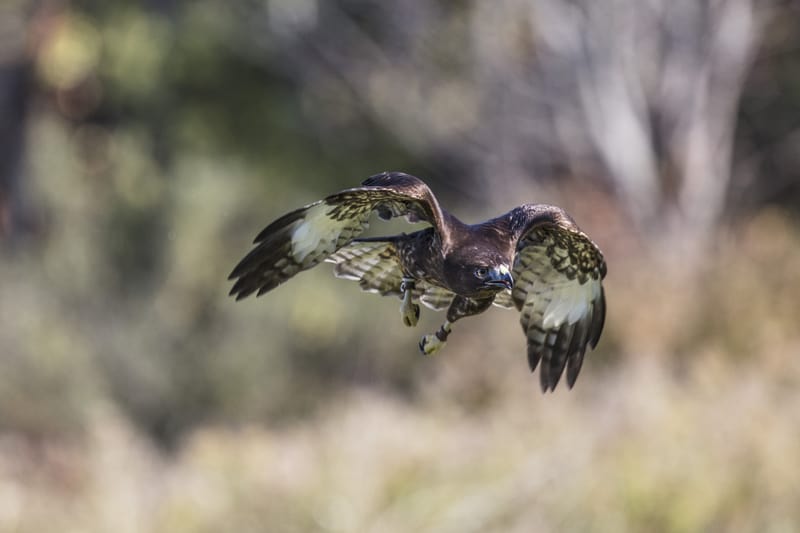Scientific name- “Buteo jamaicensis harlani“
The Harlan’s hawk is a sub-species of red-tailed hawk endemic to the United States and Canada. It was named Harlan’s buzzard or black warrior with the taxonomic designation “Falco harlani” by John J. Audobon. He named the bird in honor of his friend, Dr. Richard Harlan, in 1830.
Harlan’s hawks spend the summer in Alaska and northwestern Canada. One hundred percent of their breeding grounds lie within the boreal forest region. However, in the wintertime, they make their way into the United States as far south as Texas and Louisiana.
Since 1830, when Dr. Audobon gave its original name, the true scientific classification of the Harlan’s hawk has kept ornithologists debating even up to this present time. The bird kept its first designation as an individual species for sixty one years. However, in 1891 it was reclassified as a Red-tailed hawk subspecies.
Its subspecies designation lasted until 1944, when it was again classified as a distinct species. The story doesn’t end there, though, because, in 1972, it was again reclassified as a Red-tailed hawk subspecies. As of March of 2022, the bird is still classified as a Red-tailed hawk subspecies. However, some authoritative voices within the ornithological community contend that it should be classified as a separate species. See, Harlan’s Hawk differs from Red-Tailed Hawk, especially in plumages by William S. (Bill) Clark.

Harlan’s Hawk Characteristics
Harlan’s hawks are similar to Western red-tailed hawks in size and dimension. They differ from all other red-tailed hawks in their plumage, while the differences between the other 11 subspecies are minor. They are sexually dimorphic in size, with females being larger than males. In western Kansas, a female Harlan’s hawk weighed in at 1629 grams or 3.6 pounds. Source This is on the upper end of the size spectrum for Red-tailed hawks.
Harlan’s hawks have extreme variation in their plumage. They come in light, dark, and intermediate color morphs. However, according to the Sibley Guide to Birds, light morph birds only make up about 1% of the total Harlan’s Hawk population.
According to “Comparison of Harlan’s with Western and Eastern Red-tailed Hawks” by Jerry Liguori and Brian L. Sullivan, dark morph Harlan’s hawks are partly or completely black or dark brown on their underbody with varying amounts of white markings. Meanwhile, only 7 to 12% of these dark morph birds are completely dark on their underbodies. It’s important to note that only solidly colored birds are called dark morphs in most field guides. A Harlan’s hawk with white streaking on the breast or mottled underwing coverts is called an intermediate color morph.
Differences Between Harlan’s Hawks And Other Red-Tailed Hawks
Of the 11 other red-tailed hawk sub-species, only the western red-tailed hawk (Buteo jamaicenis calurus) has dark color morphs. These make up 1 to 2% of their total population. This is completely opposite of Harlan’s hawks, as 88–92% of them are dark morphs.
Harlan’s Hawks also have an intermediate morph between light and dark that comprises 5% of their total population. Intermediate morphs are not seen in other red-tailed sub-species adults.
Again, from Liguori and Sullivan, adult Harlan light morph birds are usually snow white below. However, they sometimes do exhibit buffy or rufus tones, dark patagial bars (patagium are the wing linings that extend on the leading edge of the wing from the neck to the wrist), and a belly band.
Harlan’s hawks don’t have a red tail like other red-tailed hawks. They typically have a white tail on top that may be mottled with black or dark brown.
Another difference between Harlan’s Hawks and other red-tails is that the feathers come down much further on the legs of Harlan’s hawks than they do on other red-tails. For example, from HARLAN’S HAWK differs from RED-TAILED HAWK, especially in plumages, the length of the bare tarsus on an adult Harlan averages 32 mm while the average bare tarsus on western red-tailed hawks measures 14.4 mm.
Summery
- Harlan’s Hawks are large hawks of the Buteo genus that summer in northwest Canada and winter in the United States, as far south as Texas and Luisiana.
- Initially, in 1830, Harlan’s Hawks were listed as a distinct species. However, in 1861 they were listed as a sub-species of red-tailed hawk. In 1944 they were relisted as a distinct species. Subsequently, in 1971 they were listed as a red-tailed hawk subspecies once more.
- Ornithologists are still debating the true taxonomic classification of Harlan’s hawks due to the similarities and distinctions between them and red-tailed hawks.


